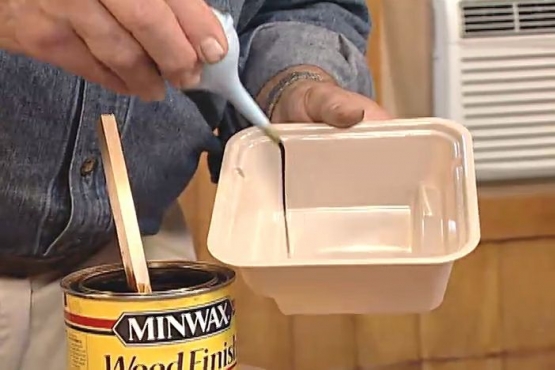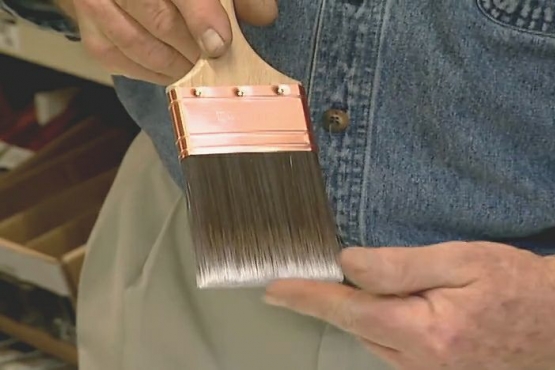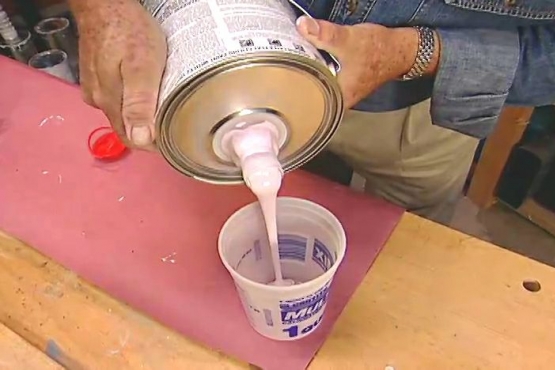How to Make a Pickled or White Wash Finish
Using Minwax Whitewash Pickling Stain
In this project, Ron is finishing a brand new pine cabinet with a Minwax product called a pickling stain. The final product is a flash back to the styles of the Mark Twain era, and creates a clean, country look that fits will in the decor of many homes.
Read More
Prepare the Cabinet
Begin by removing the doors of the cabinet. Sand all of the surfaces using a quarter of a sheet of 120 grit sandpaper that has been folded into thirds. The result is a sanding pad that is the perfect size to fit in the palm of your hand. Make sure that you always move in the direction of the wood grain. You may also find it helpful to wrap the sandpaper around a block of wood. This will give you a sharper edge to work into bevels and corners that may be harder to reach with your hand. For large flat surfaces, an orbital or palm sander can also be a big time saver.

Condition the Wood
Soft woods, such as the pine in this cabinet, can sometimes appear blotchy when stained. To prevent this, the wood needs to be conditioned. Ron is using a pre-stain conditioner from Minwax on this cabinet. Apply the conditioner with a clean brush designed for latex paints and then let it sit for 30 minutes. Follow up with a light sanding pass using the 120 grit paper again. The conditioner will raise the grain of the wood, and the sand paper will ensure that you have a smooth surface to apply the stain to.

Apply the Whitewash Pickling Stain
Apply the stain with the same clean brush designed for latex products that you used to apply the conditioner, making sure that it is well cleaned before you begin. The stain should be applied with long, smooth strokes in the same direction. Once the stain is applied, wipe it away with a soft cotton cloth that you've folded into a pad. Always move with the wood grain. The more pressure you apply to the pad, the more the wood grain will show through the stain on the final product.

Choose the Right Products for the Top Coat
Use a clear, water based polycrylic top coat. Ron is using Minwax for this project. Make sure you use a high quality brush, such as a Purdy, that is designed for latex or water based products, so that stray bristles don't get left behind in your top coat.

Apply the Top Coat
In the same way that you applied the stain and the conditioner, apply the water based top coat using long smooth strokes. Finish each surface with overlapping continuous strokes in a process called "striking off." When finishing around the bottom of the cabinet, put it up on small block or shims so that the polycrylic doesn't stick the furniture to the surface of the bench or floor where you are working.

Final Top Coat
After allowing the first coat to dry for about 4 hours, lightly sand the cabinet one last time with 220 grit sand paper. Use a tack cloth to wipe away any excess reside left behind by the sand paper, and then apply the second and final coat to the cabinet.
Related Tips
Blog Articles
Have You Heard of Landscape Glue?
You love the rustic charm of a gravel walkway, but the constant scattering of stones across your lawn and patio can be a real headache. Whether it’s from pets, lawn mowers, or just foot traffic, it seems impossible to keep those stones in place. Sound familiar? Well, Brian shows us a simple DIY method using landscape glue to keep your gravel path looking pristine and, more importantly, in place.
How to Remove Candle Wax Drips: Two Effective Methods
Candles create a warm and inviting atmosphere, but those pesky wax drips can be a real headache. Luckily, Brian shows us a couple of effective methods to tackle this issue, and they involve two very different temperatures: hot and cold. Here, we'll explore two effective methods: one using cold and the other using heat.
Guide to Hanging on Masonry Walls
Ever wondered how to hang that picture frame or shelf on a brick or concrete wall? It can seem daunting, but with the right tools and techniques, it's a straightforward DIY project. This guide breaks down two common methods: using concrete screws and using anchors, making it easy for you to tackle your next hanging project.










